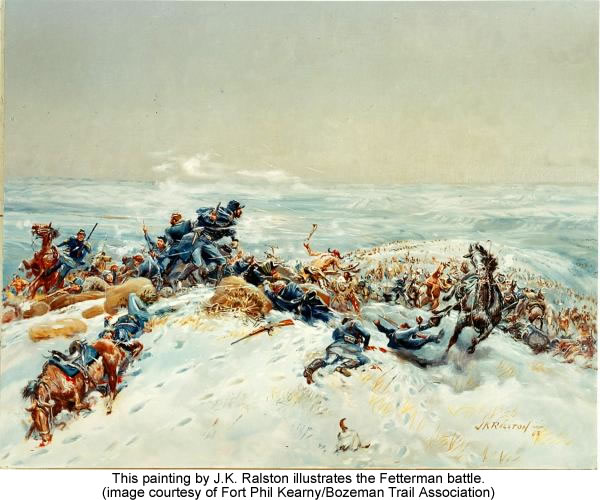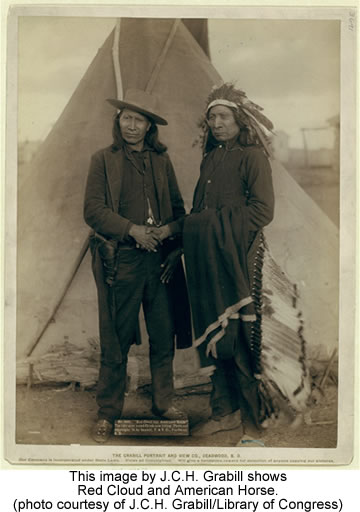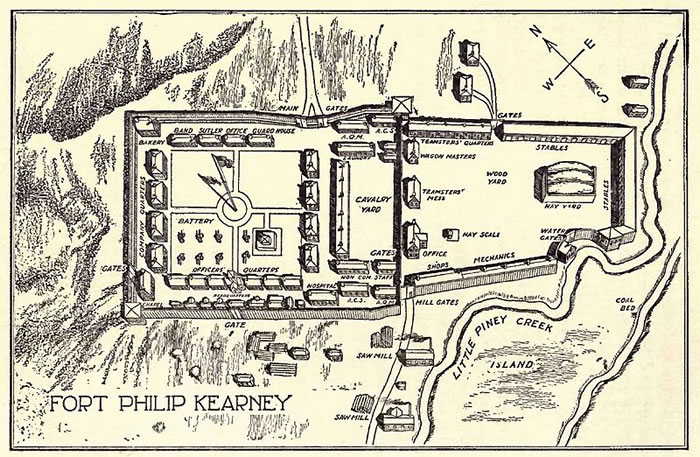 |
Canku Ota
|
 |
|
(Many Paths)
|
||
|
An Online Newsletter
Celebrating Native America
|
||
|
January 2014 - Volume
12 Number 1
|
||
|
|
||
|
Native History: Indians
Defeat Army to Protect Bozeman Trail
|
||
|
by Jack McNeel - Indian
Country Today Media Netwotk
|
||
|
This Date in Native History: On December 21, 1866, the U.S. Army suffered its second largest defeat during the Indian Wars, second only to the battle with George Armstrong Custer at Little Bighorn. All 81 cavalrymen and infantrymen died in an intense fight that lasted just 40 minutes.
The history leading up to this fight started three years earlier, in the spring of 1863. The Bozeman Trail was constructed, leading north from Fort Laramie on the old Oregon Trail into the gold fields of Montana. This brought the trail and its hoard of immigrants right through what had once been the homeland of the Crow, later the Shoshone, and then the Teton Sioux. This is the Powder River country of what is now Wyoming. It was open land but good land as game was abundant and fruits and berries grew along the waterways.
Two Sioux Indian leaders, highly regarded and remembered today, vowed to fight any white man using the Bozeman Trail—Red Cloud and Crazy Horse. The first raid on the fort occurred on July 16 resulting in two deaths. Attacks on wagon trains happened frequently, but work continued on the fort. Two more of the military died on December 6 and gave the Sioux the belief they could overpower any assignment from the fort. Indian warriors were becoming increasingly confident in part due to a medicine man who had four visions of increasing numbers of dead soldiers. The fourth vision showed that 100 soldiers would die. December 21, 1866: A wagon train was sent out from the fort to return with wood. Less than an hour later they were attacked by a decoy party of Indians. The regimental commander, Colonel Carrington, had warned his troops not to be fooled by a trap, something he had seen employed by the Indians before. The relief force to help the wood train was led by Captain Fetterman who had little respect for the Indians and had commented earlier that a company of regular soldiers could whip a thousand Indians, a big mistake as he was about to find out.
The initial decoy party retreated up Lodge Trail Ridge where decoys were standing, yelling and gesturing at the soldiers. When the soldiers reached the top of the ridge they likely only saw a few Indians near Peno Creek in the valley below. It was now about noon. As the troops approached the valley, the huge force of Indians stood in the high grass and firing commenced. Most of the Indians were shooting arrows, but that was more than enough. Just 40 minutes later all the military troops were dead, including Fetterman who had once said that a regiment could whip the whole array of hostile tribes. As many as 40,000 arrows were released in that 40-minute span—it was an overwhelming victory, second only to Little Bighorn, but 60 Indian warriors also died. Attacks along the Bozeman Trail continued and only heavily armed military trains were able to pass along the trail. In 1868 the three forts guarding the Bozeman Trail, including Fort Kearny, were abandoned and Indians burned them to the ground. On November 6 of that year Red Cloud signed a peace treaty, thus ending the Bozeman Trail War, part of which was the Fetterman Massacre but called by the Sioux as the Battle of the Hundred Slain.
|
|
|
||
|
|
||
| Canku Ota is a free Newsletter celebrating Native America, its traditions and accomplishments . We do not provide subscriber or visitor names to anyone. Some articles presented in Canku Ota may contain copyright material. We have received appropriate permissions for republishing any articles. Material appearing here is distributed without profit or monetary gain to those who have expressed an interest. This is in accordance with Title 17 U.S.C. Section 107. | ||
|
Canku Ota is a copyright ©
2000 - 2013 of Vicki Williams Barry and Paul Barry.
|
||
 |
 |
|
|
The "Canku
Ota - A Newsletter Celebrating Native America" web site and
its design is the
|
||
|
Copyright ©
1999 - 2013 of Paul C. Barry.
|
||
|
All Rights Reserved.
|
||

 Some
chiefs were determined to close the Bozeman Trail. Indian attacks
became more common and travel was risky. Then U.S. soldiers were
brought in to guard the trail. Perhaps what really ended negotiations
was the plan to build Fort Kearny with orders to guard the Bozeman
Trail.
Some
chiefs were determined to close the Bozeman Trail. Indian attacks
became more common and travel was risky. Then U.S. soldiers were
brought in to guard the trail. Perhaps what really ended negotiations
was the plan to build Fort Kearny with orders to guard the Bozeman
Trail. Fetterman
wanted a fight, and the Indians were ready. There might have been
as many as 2,000, mostly Sioux with some Cheyennes and Arapahos,
waiting out of sight on the backside of Lodge Trail Ridge. Red Cloud
is thought to have been in that huge group of warriors. A second
decoy party approached the fort and drew artillery fire. Crazy Horse
was part of that party. The man responsible for the plan was High-Back-Bone,
a Minneconjou Sioux.
Fetterman
wanted a fight, and the Indians were ready. There might have been
as many as 2,000, mostly Sioux with some Cheyennes and Arapahos,
waiting out of sight on the backside of Lodge Trail Ridge. Red Cloud
is thought to have been in that huge group of warriors. A second
decoy party approached the fort and drew artillery fire. Crazy Horse
was part of that party. The man responsible for the plan was High-Back-Bone,
a Minneconjou Sioux.